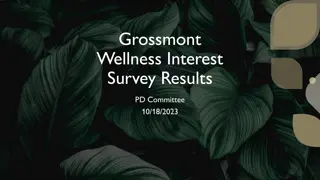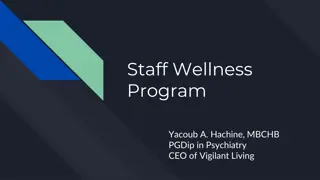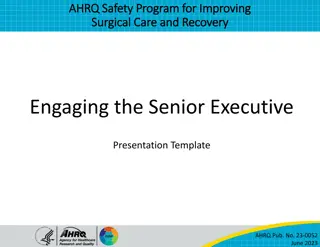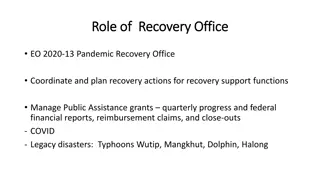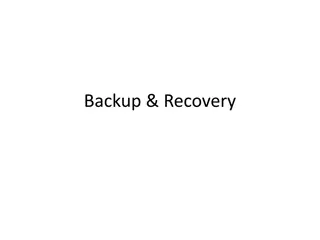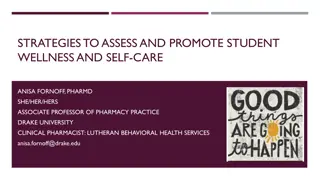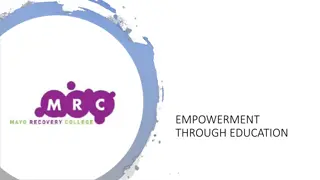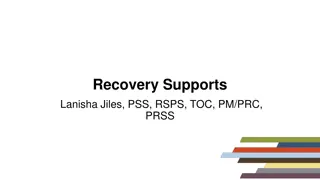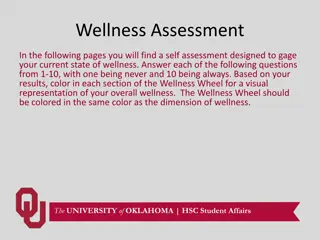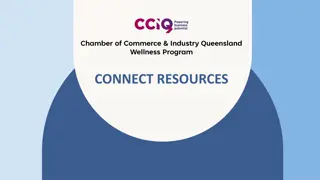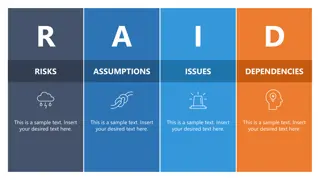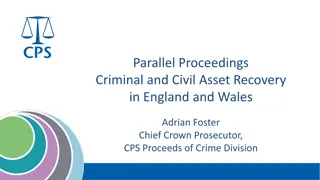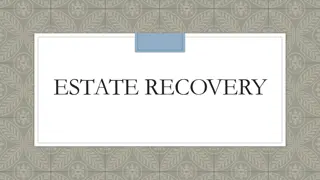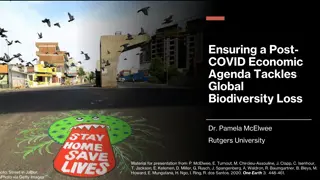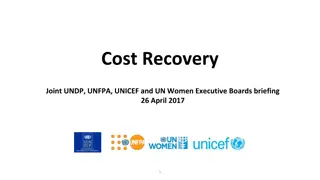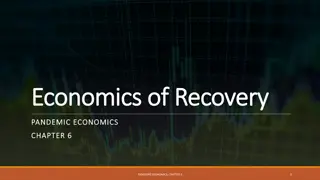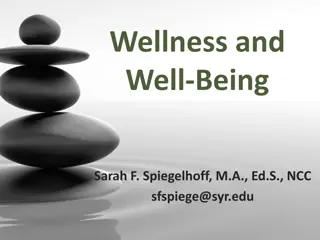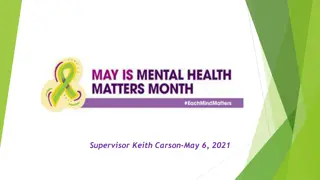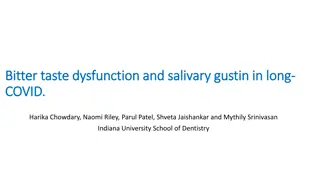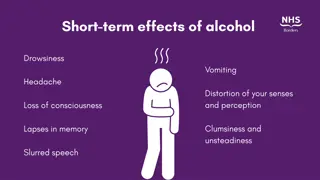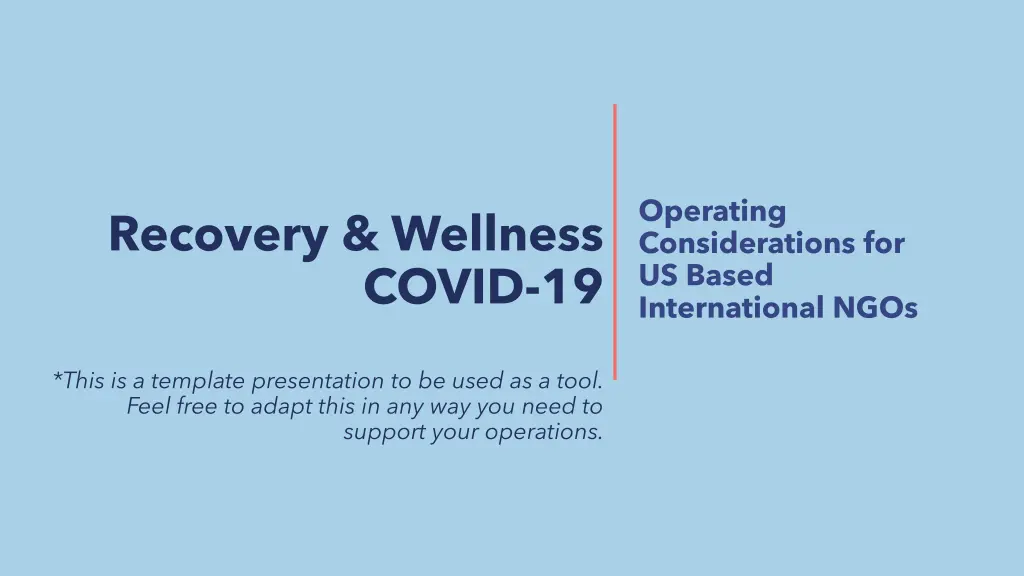
NGO Operating Considerations for COVID-19 Recovery
Discover essential considerations for US-based international NGOs to navigate the recovery phase post-COVID-19. Topics covered include human resources, staff benefits, insurances, and operational security.
Download Presentation

Please find below an Image/Link to download the presentation.
The content on the website is provided AS IS for your information and personal use only. It may not be sold, licensed, or shared on other websites without obtaining consent from the author. If you encounter any issues during the download, it is possible that the publisher has removed the file from their server.
You are allowed to download the files provided on this website for personal or commercial use, subject to the condition that they are used lawfully. All files are the property of their respective owners.
The content on the website is provided AS IS for your information and personal use only. It may not be sold, licensed, or shared on other websites without obtaining consent from the author.
E N D
Presentation Transcript
Operating Considerations for US Based International NGOs Recovery & Wellness COVID-19 *This is a template presentation to be used as a tool. Feel free to adapt this in any way you need to support your operations.
Overview After the outbreak of the COVID-19 pandemic, the International NGO (INGO) community recognized the need to adapt the way they work and approach operations in order to maintain their duty of care to all staff. The resulting content, Recovery & Wellness Post-COVID-19, brings together subject matter experts and practitioners to provide guidelines for Post-COVID-19 transitioning in the following areas: HUMAN RESOURCES INSURANCES & BENEFITS STAFF WELLBEING TRAVEL & JOURNEY MANAGEMENT OPERATIONAL SECURITY
Human Resources Overall, what level of risk is your organization prepared to absorb with regard to the health and safety of your staff? The Human Resources should work with various teams in the organization to evaluate important considerations in order to determine the most appropriate time and method for re-opening an office that has been closed due to COVID-19. These considerations include: How necessary or essential to the mission is it for staff to return to the office or a post location prior to there being a vaccine or therapy in place? Has a conversation taken place at the senior leadership level which outlines the organization's position on adequate protections needed to protect the health of your staff within your offices? Do you have clear and adequate leave policies and processes in place? Are your company protocols and policies in compliance with local laws, new rules from OSHA, government agencies and health organization guidance? Does your Duty of Care Program include all of the necessary components?
Human Resources Action List Review the Recovery & Wellness, COVID-19 Highly Recommended, Recommended and Beneficial Human Resources & Facilities Action List. Assess which actions are appropriate for your organization and include them here.
Staff Benefits & Insurances A strong benefits package and insurance portfolio will provide support for both employees and management at any time but particularly during a crisis such as COVID-19. Before beginning re-entry that would require travel or potentially put staff at additional risk it is important to evaluate your coverage and any changes in your legal obligations. Assess how COVID-19 affects your coverages and where gaps may occur Review current staff benefits & insurance policies Determine the appropriate new coverages needed Understand your population types
Staff Benefits & Insurances Action List Review the Recovery & Wellness, COVID-19 Highly Recommended, Recommended and Beneficial Human Resources & Facilities Action List. Assess which actions are appropriate for your organization and include them here.
Staff Wellness In times of crises employers have a duty of care to help prepare and support staff -- local and international -- to face known challenges and risks that will affect their physical and psychological well being. Support to Frontline Personnel Prior to Assignment and Travel While Employed and/or On Assignment Support to Managers Work from Home
Staff Wellness Action List Review the Recovery & Wellness, COVID-19 Highly, Recommended and Beneficial Human Resources & Facilities Action List. Assess which actions are appropriate for your organization and include them here.
Travel & Journey Management Be cautious in authorizing travel and returning to work during the COVID-19 pandemic Warn of relevant risks before travel Identifying a point person or team to remain informed about the new risks, recommendations over time will become considerably more challenging Create and educate staff and managers on a policy that protects against pressuring staff to travel if it is beyond an individual s acceptable level of risk
Travel & Journey Management Action List Review the Recovery & Wellness, COVID-19 Highly Recommended, Recommended and Beneficial Human Resources & Facilities Action List. Assess which actions are appropriate for your organization and include them here.
Operational Security Risk Assessments Economic Fallout Safe- guarding Political Fallout Crime Digital Security Terrorism Anti- Foreigner Sentiment Travel
Operational Security Re-Entry Limited Full Preparation Implementation Implementation
Key Assumption for Re-Entry 1. Office reopening should be gradual and follow best practices for physical distancing and other risk mitigation measures following a thorough and ongoing risk assessment. 2. Each field project/office should conduct location specific risk assessments and develop mitigation plans. 3. Decisions to open offices and the creation of resources and policies should have clear approval protocol. 4. When offices are reopened, employees should be able continue working from home if possible. 5. Staff who exhibit symptoms or test positive should not be allowed in the offices until advisable by CDC guidelines.
Considerations for Re-Entry Disease Prevalence and Reliability of Data Has there been a downward trajectory of documented cases? If so, for how many days? Location(s) of the cases reported are there active outbreaks in areas where we have offices and/or staff living? Government Restrictions Is there a government lockdown? Are non-essential businesses open or closed? If closed, what is the timing of non- essential businesses re-opening? Are schools or childcare (if applicable) services closed? Is PPE required? If so, what is and where is it required? Movement restrictions What impact will these have on commute and is safe transport possible? Can people access essential services?
Considerations for Re-Entry Medical Capacity and Testing Critical Programmatic Requirements Is there a critical business need that the organization should consider when thinking about the timeline for re-opening an environment? Based upon those needs, which staff member(s) will be critical in achieving those goals, keeping in mind that the organization may want to limit its headcount as much as possible in the early re-opening phases. Are there medical facilities in country equipped to treat critical cases of COVID-19? If so, how far do staff need to travel to access medical care and is that travel feasible? What type(s) of testing is available in country? Is any of that testing mandatory? Availability of testing do staff, partners, family members, etc. have access? Is medical evacuation available in country?
Considerations for Re-Entry Security Situation in Country Has the organization and any partners (if applicable) conducted an updated risk assessment (frequency to be determined by re-opening phase)? Are there plans in place to mitigate unacceptably high risks and/or new risks associated with COVID-19? Have donor offices re-opened, if applicable? Examples of criminality trends in country to be considered (not exhaustive): Economic situation Unrest, disregarding of social distancing Crimes related to increased food insecurity Terrorism Community Response and Adherence to Restrictions Is the community adhering to social distancing? Is the community adhering to government restrictions, if applicable? Is the community wearing masks/washing hands/avoiding physical greetings? Is there evidence of COVID-19 restriction fatigue in the community? Are there signs of stigma against anyone who has a confirmed case of COVID-19 and/or against health workers? What is the staff opinion and/or feedback? Have staff expressed that they would be willing to seek treatment at facilities, etc.?
Scenario 1 You receive a call from a Country Director (CD) to report that an international staff adviser expected to be picked-up at the airport had not appeared. The CD was able to contact the staff member (a US citizen) who reported that she had been detained under the airport health screening regulations and would soon be transferred to a government COVID-19 quarantine facility. The staff member was quite upset as she had not had any symptoms related to COVID-19 but feared that being quarantined with others may expose her to the virus. The Security Director activates the Emergency Management Team. 1. What actions would you take to address: Duty of care responsibilities Staff health and safety Staff well-being 2. Who would you notify? 3. How might this situation have been avoided?
Scenario 2 Your organization has recently re-opened your country office after having deep cleaned the facility, reconfigured the office space to ensure social distancing, provided PPE, and established new protocols for safe and healthy operations. Over the course of a few weeks, your local Human Resources manager reports that staff, including local and international staff, starting to code time to sick days. Upon review, it is clear that these staff work in the same section of the office. 1. What are the immediate concerns of the Emergency Management Team? 2. What are the immediate concerns of the Country Management Team? 3. What actions would you take to address: 1. Duty of care responsibilities 2. Staff health and safety 3. Staff well-being 4. Who would you notify? 5. How might this situation have been avoided? The facilities manager reports that one of the sick staff lives in a multi- generational home with many family members. Since they believe they became exposed to COVID-19 in the office, they are asking for money to self-quarantine at a hotel. Other staff are concerned that the new facility standards are not robust enough and that the organization is not doing enough to protect their health. There is an expatriate staff in the office who is now uncomfortable continuing to work in that location. However, they are concerned that if they are repatriated, they will lose their job.

